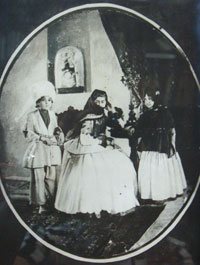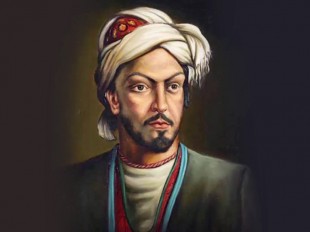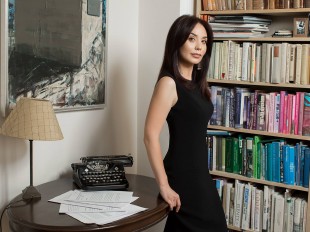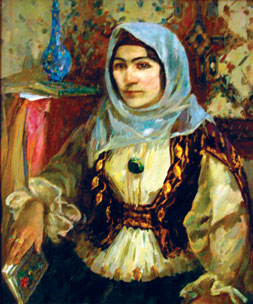 Portrait of Khurshid Banu Natavan, oil on canvas by Oqtay Sadiqzade 1970, Nizami Ganjavi museum of Azerbaijani Literature
Portrait of Khurshid Banu Natavan, oil on canvas by Oqtay Sadiqzade 1970, Nizami Ganjavi museum of Azerbaijani Literature by Togrul Efendi
The Alexandre Dumas Museum in Paris displays a hand-crafted, beaded tobacco-pouch, personally embroidered by Princess Natavan of the Karabakh Khanate. The memento was presented to the writer at a party during his trip through the Caucasus in 1858. Dumas was fascinated by the pouch, calling it the most ´valuable gift´.
Natavan is, however, better known in Azerbaijani culture as a poet. Her poems, imbued with the lyricism of love, are highly appreciated by connoisseurs of Oriental poetry. Natavan Khurshid Banu Mehti Quli khan qizi was born in 1832 in Shusha, a fortified town founded by her grandfather Panah Khan. The princess, the last representative of the Karabakh ruling family, received her education here in Shusha (she knew several Oriental and European languages and had a good understanding of music). Something of a Renaissance woman, Natavan was interested in many aspects of the life of her people. She owned Karabakh´s first stud farm, laid the first water main in Shusha and accomplished a great deal in health and education.
Shusha at the end of the 19th century had many scientific and artistic societies. Khurshid Banu (the Sun Beauty) was known for her progressive outlook and the bohemian company she kept. She led the Majlis-i Uns music and poetry circle which reflected the values of the new Age of Enlightenment. The same tendencies towards European cultural style can be seen in Natavan´s drawings, including her elegant pencil sketches, and her decorative embroidery.
One of her contemporaries, the poet Hasan Yuzbashi, praised Natavan´s embroidery in his poetry. He said he ´cannot not imagine that the hand of a human being was able to create this masterpiece, as deserving of glory as the works by the best artists of the East, such as Behzada and Mani´.
Reports in Kavkaz newspaper in 1882 show that Natavan took part in Russian and European exhibitions, and several times received top awards.
Natavan´s work can now be seen in the Museum of Azerbaijan. The most attractive are household articles decorated with beads and pearls (curtains, counterpanes, covers, etc.).
The picture compositions are highly decorated scenes of people, animals, birds and floral motifs. The cover for a hookah-pipe from the Azerbaijani History Museum´s collection is astonishing in its bead decoration. Coloured beads depict a rich flower design on a white backdrop. Inspired by scenes from her native Shusha, the artist represents nature very poetically. The same museum has a purse decorated with bead embroidery which shows a loving couple in the tradition of Azerbaijani miniature painting.
At the Institute of Manuscripts of the Academy of Sciences you can turn over the pages of a small format album with 13 ghazals written by Natavan and poems by her contemporaries. The album is illustrated with 30 lead pencil drawings by Khurshid Banu. Native mountain landscapes, village and town scenes, sea shores, decorative flowers and birds - all these images are in tune with the emotions of Natavan´s poetry, in both their style and lyricism. The drawings show the stylistic trends in painting and in Azerbaijani culture in general in the 19th century. We can see the process of the
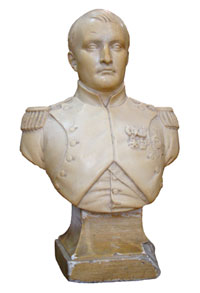 Napoleon Bonaparte’s bust presented to Natavan by Alexandre Dumas, after he lost to her at chess, Uzeyir Hajibayov´s house museum
Napoleon Bonaparte’s bust presented to Natavan by Alexandre Dumas, after he lost to her at chess, Uzeyir Hajibayov´s house museum In Natavan´s work we can see not only the principles of composition, but also separate elements known to us from European painting and Oriental graphic art. However, distinct from the abstract aesthetics, Natavan´s work is suffused with lyrical emotion.
A desire for innovation in her work and an interest in using new methods are characteristic of Khurshid Banu Natavan the artist. This can be seen in her album cover, decorated with needlework in 1304 in the Islamic calendar, 1866.
